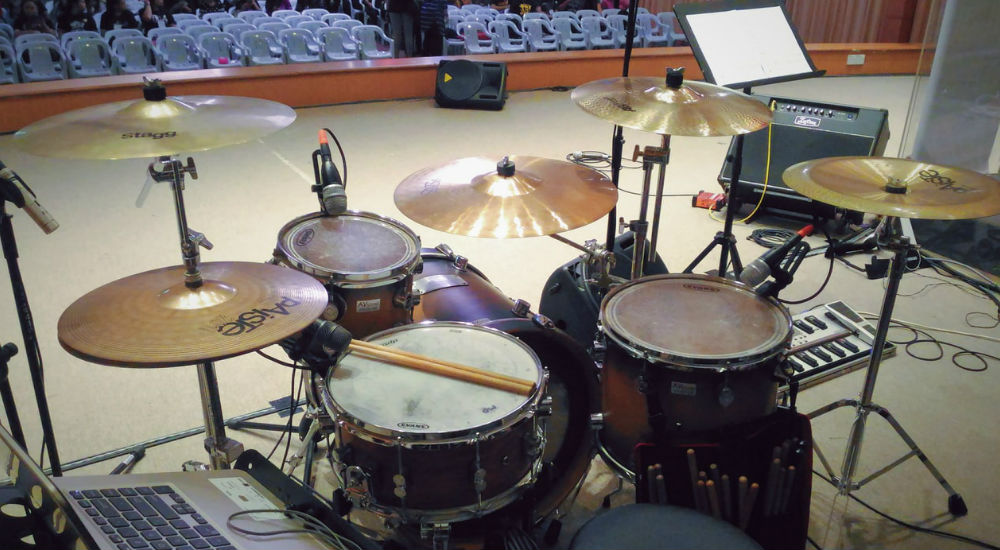Practise you say?
Yep. It’s damn hard to fit in regular practise into the week these days. Being the Head of Music at a secondary school, a Dad and weekend gig warrior takes its tole on spare time. My secret? Short bursts of being In The Zone. A teacher once used this term to me and the best way I can describe it is being totally focused on that task at that time. If I choose to sit at the drums, in a tiny window of spare time, I have two choices. Firstly, I could just muck around, jam out and regurgitate all the stuff I already know how to play – which is fun, and I do this for sure. But secondly, I could work on a concept, feel, groove or fill that I can’t play. At that moment, even if it’s a few minutes, if it’s in the zone, I can learn something.
What is In The Zone at the moment?
Just this week, some students came into lessons and as some of them tend to do at the end of the year, practised very little. I decided to change things up and just throw them in the deep end with a concept that I’ve been fascinated with and always seem to come back to a lot when I have a moment. I figured the basis for the concept is what matters and this one can apply to anything. I like to think of it as being a bit of bang for your buck concept – getting the most out of one idea. I won’t go into every single idea or variation but let’s take a couple of concepts from easier to harder and explore the variations of orchestration and moving between subdivisions.
The best thing about this is that it can apply to something you already know so the first idea is probably something people have played before. Figure A shows us a simple Right Left Kick (RL K) sticking. Figures B – D show the same three note sticking orchestrated as 16th notes. Figure C adds some alternating hands. This concept isn’t new really but when you start to move the hands around the different sounds on the drum kit, it’s still so great to hear the vibe and flow of the fill change. Be mindful, you need to be able to feel the new subdivision and so, it’s a great timing/metronome exercise too!
Combine ideas
Getting slightly more involved is Figure E, which is actually two licks I use regularly involving adding a double bass drum figure and then applying the concept in the same way (Figures F and G). However, the move from 16th notes into 16th note triplets can be slightly trickier so, if needed, play the figures in half time but take it slow either way. I find that 16th note triplets creep their way into my playing very often and are applicable across many grooves/feels. Note the differences that occur when you experiment with the orchestration. The move to orchestrate, mix and match the stickings between subdivisions and add a hi-hat really creates contrast in the overall sound and makes the fill sound way more complicated than it has any right to.
The last figure comprises two of my favourite stickings. One is actually the Steve Gadd 6-stroke Roll and the other one is heavily Gadd inspired too but comprises some accents and the use of the bass drum on the end of the group of six. With all the figures, you can split up if needed but I like the outcome of mixing a couple together. After moving the figure from triplets to 16th notes, you already have a wicked sounding fill (Figure I) but adding toms and cymbals just opens up your ears to new ideas. Study the notation carefully to see some options to explore.
Being smart
Now, even though you are just playing the fills, stickings and licks you already know, the different subdivision coupled with clever orchestrations will not only shine a new light on the ideas but also where and how you apply them on the gig across different situations. It’s really smart practise when you have a spare moment. Experiment as much as you can – grooves, tempos, styles, accents, odd subdivisions (quintuplets, septuplets etc) and see where it takes you. You might spark some new ideas whilst getting great mileage out of your current fills and ideas. Possibilities are literally endless. Remember to practise in context of where the fill might be applied though, so it makes sense on the gig. Hope this was educational and gets you in the zone too.
Can’t be bothered learning drums? Me neither. We’re giving away an IK Multimedia UNO Drum this month, so you don’t have to learn!








